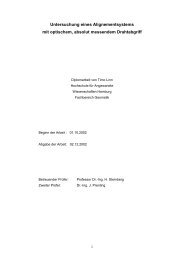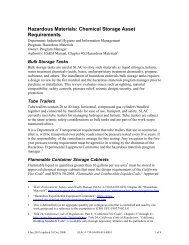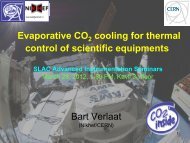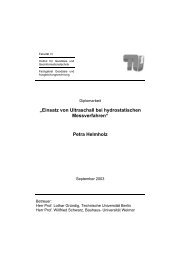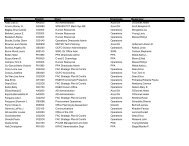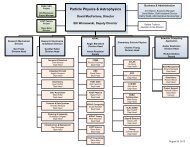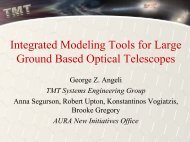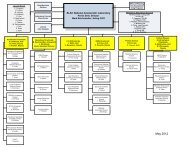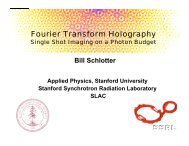BES - SLAC Group/Department Public Websites - Stanford University
BES - SLAC Group/Department Public Websites - Stanford University
BES - SLAC Group/Department Public Websites - Stanford University
You also want an ePaper? Increase the reach of your titles
YUMPU automatically turns print PDFs into web optimized ePapers that Google loves.
FYO7 <strong>SLAC</strong> S CIENCE AND T ECHNOLOGY S ELF E VALUATION<br />
Electro-Optic Bunch Length Monitor and Timing Diagnostic: A noninvasive technique was<br />
developed and tested at SPPS to record femtosecond electron bunches arrival time with respect to a<br />
pump laser pulse. Although the arrival time fluctuates from pulse-to-pulse, this information can be<br />
used to place repetitive measurements in sequence with femtosecond resolution. The optical<br />
properties of an electro-optic crystal placed adjacent to the electron beam are strongly modified as a<br />
result of the electric field of the electron bunch as it passes. A femtosecond laser pulse propagating<br />
through the crystal at the same time as the transient birefringence is induced has its polarization state<br />
altered and can thus be used as a probe of the relative arrival time of the electron bunch. By making<br />
use of cross-beam geometry, a range of times is measured and the timing information, including<br />
electron bunch length information, is imprinted on the spatial profile of the transmitted laser beam.<br />
Coherent Imaging: A collaboration with FLASH includes experiments probing high intensity,<br />
nonlinear interaction of x-rays with materials, radiation chemistry in liquids, and catalysis on<br />
surfaces.<br />
Attosecond Pulses: A new project focuses on producing attosecond pulses in the extreme ultraviolet.<br />
In a short time we have become world competitive in the analysis of high harmonics from aligned<br />
molecules, and have novel results that impact the interpretation of electron wave functions in HHG<br />
processes.<br />
THz: During FY07, we commissioned a laboratory-scale setup for generating high field THz halfcycle<br />
pulses, generating among the highest fields ever produced from a table-top source, using a<br />
setup that is simple and easily adopted. Evidence of performance comes from the very large number<br />
of publications, invited talks, and awards in FY07.<br />
Awards and Invited Papers<br />
SSRL William E. Spicer Young Investigator Award (co-winner)<br />
D. M. Fritz, Menlo Park, CA, awarded October 2006<br />
<strong>University</strong> of Michigan Rackham School of Graduate Studies Distinguished Dissertation<br />
Award<br />
D. M. Fritz, Ann Arbor, MI, awarded May 2007<br />
Freie Universitaet Ernst Reuter Prize for best PhD thesis<br />
M. Gühr, Berlin, Germany, awarded December 2006<br />
The invited papers list is incorporated into the <strong>Public</strong>ations Appendix. In all, PULSE staff presented<br />
45 invited papers in FY07.<br />
Notable <strong>Public</strong>ations<br />
Software Defined Photon Counting System For Time Resolved X-Ray Experiments, Y. Acremann, V.<br />
Chembrolu, J. P. Strachan, T. Tyliszczak and J. Stöhr, Rev. Sci. Instrum., 78, 014702 (2007)<br />
We designed a novel software defined photon counting system that allows implementation of a<br />
variety of pump-probe schemes at full repetition rate. The high number of photon counters allows<br />
one to detect the response of the sample at multiple time delays simultaneously, thus improving<br />
the experiment’s efficiency. The system has been successfully applied to time resolved scanning<br />
transmission x-ray microscopy, yet is applicable more generally.<br />
Magnetization dynamics: ultra-fast and ultra-small, Y. Acremann, Comptes Rendus - Physique,<br />
accepted for publication<br />
Ultrafast magnetic processes are of great scientific interest but also form the basis of high density<br />
magnetic recording applications. We demonstrate the uniqueness of time resolved, high<br />
resolution magnetic x-ray microscopy, and show that the motion of a magnetic vortex core can be<br />
imaged. The vortex core direction is hidden to most experimental techniques, but has a decisive<br />
influence on the dynamics of the magnetic structure.<br />
F I N A L P A G E 1 5



